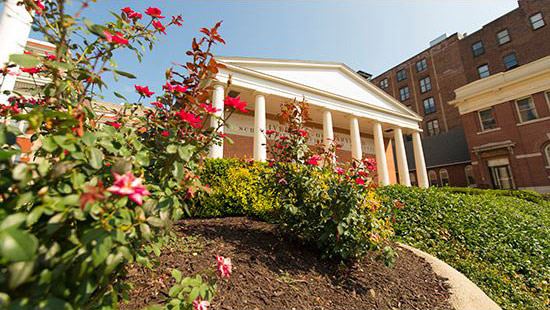Our History - Transplant Surgery Fellowship

Organ transplantation has been a core component of the Department of Surgery for more than three decades.
After initial efforts in transplantation focused on renal transplantation in the 1980s pancreas transplantation followed in 1991 and liver transplantation in 1994.
The program since has been a national leader in terms of transplant volumes and innovation for more than twenty years.
Maryland was the first institution to demonstrate equivalent survival with pancreas transplant alone compared to simultaneous pancreas-kidney transplants and recently sponsored the first ever drone-delivered organ transplantation.
We have performed more than 1500 liver transplants, 1000 pancreas transplants, and 6000 renal transplants in total. In homage to those who have come before us, our program continues to use Davidge Hall for journal club presentation by fellows.
University of Maryland School of Medicine
Physician training has been a core principle of the University of Maryland School of Medicine for more than two centuries. Charles Wiesenthal established the Medical Society of Baltimore in 1789 (after serving as a physician to Frederick the Great of Prussia) and taught anatomy to students for the next decade.
These early efforts led to the establishment of the Medical and Chirurgical Faculty of the State of Maryland in 1799. This informal home-based medical teaching among several prominent Baltimore physicians later transitioned into an educational building in 1807. Interestingly local outcry over cadaver dissection led to rioting and actually the eventual destruction of the building. This prompted the State of Maryland to establish the College of Medicine of Maryland (later renamed the University of Maryland School of Medicine). Davidge Hall was constructed in 1812 and has the distinction of being the oldest building used for medical education in the United States.
University of Maryland Medical Center
The medical school has maintained a close relationship with the University of Maryland Medical Center for almost 200 years. Founded first as the Baltimore Infirmary in 1823 by professors of the College of Medicine of Maryland, the initial building was composed of four wards and sixty beds. One semicircular operating theater permitted observation of the operations of the day. As was customary at the time, resident physicians lived at the Baltimore Infirmary which later became University Hospital in 1867.
Ultimately, the state-owned hospital transitioned to the not-for-profit University of Maryland Medical Center which now trains more than 50% of Maryland clinicians, and has more than 30,000 inpatient and 300,000 outpatient visits per year.
